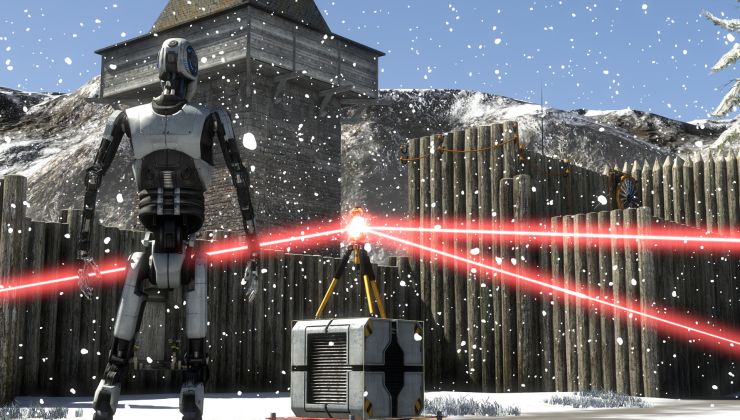Along with announcing their new Raptor Lake desktop CPUs, Intel has also finally announced the release date of their Arc A770 GPU for October 12th. This is their top-end GPU, that they claim "delivers 65% better peak performance versus competition on ray tracing".
Coming in at $329, putting it in line with the RTX 3060 which they previously compared it against. They're facing some fierce competition with NVIDIA and AMD already well established in the market although given the insane price on NVIDIA Ada Lovelace, perhaps more will be looking at alternatives?
Very little else was really said about it that I can find, other than what they've previously revealed about it which is pretty much everything with all the specifications already available on their website. As a refresher, their Limited Edition version is mainly the card with the 16GB GDDR6 and they said previously most of their partners will do it in 8GB.
You can find out more on the Intel website. The XeSS SDK is also now available on GitHub.
I'm keen to see how Intel do with their first lot out properly, as a third vendor has been needed like this in the GPU space. With open source drivers too, there's a lot for Linux users to like about it.
BTW, off-topic but it's just impressive how bad of a game Fortnite and Cyberpunk are. And Cyberpunk, at least, has the excuse of beautiful graphics.
I've phased out nearly all Intel CPUs as Ive been on Thank You AMD phase, so this is a weird turn for me -- I just acknowledge Intel has had a open source driver since forever.
Open source drivers dictates a much higher probability I will buy something.
Last edited by ElectricPrism on 27 Sep 2022 at 8:13 pm UTC
I think the price may be okay given good driver support, I'll keep an eye out for benchmarks.
Last edited by pageround on 27 Sep 2022 at 9:26 pm UTC
I want Intel to succeed but sadly expecting disaster.
But I think their hardware will need a few generations to really close up.
As well do the drivers. They do not have a good track record there. I hope this initiative will get them there.
Nvidia opened up considerably, AMD is great, and pressure from the Intel side will certainly help.
I want Intel to succeed so bad.
BTW, off-topic but it's just impressive how bad of a game Fortnite and Cyberpunk are. And Cyberpunk, at least, has the excuse of beautiful graphics.
and Fortnite has the excuse of supporting split screen in an age where game developers think that nobody should be making physical friends anymore :(
Or maybe they think everyone should just buy a Steam Deck 🤔
If it's a good step up from, say my 1070ti and has a decent cooler, at that price, that's an upgrade I can afford!
Last edited by denyasis on 28 Sep 2022 at 12:52 am UTC
Last edited by Xaero_Vincent on 28 Sep 2022 at 1:11 am UTC
I'm thinking of buying one for a server or something. I very much hope the GPU War of the future is AMD vs Intel and Nvidia can go away (mostly) -- which since EVGA is no longer making NVIDIA seems likely as they were #1.
I've phased out nearly all Intel CPUs as Ive been on Thank You AMD phase, so this is a weird turn for me -- I just acknowledge Intel has had a open source driver since forever.
Open source drivers dictates a much higher probability I will buy something.
Nvidia is not going anywhere... They rule in the AI and Data science world with CUDA, AMD is second class for say that has something. Perhaps Intel and AMD can take the gamer market and the low cost market, but where the big bucks are expended will be on these [A 100](https://www.nvidia.com/en-us/data-center/a100/)
Just my humble opinion!
I wish they had stuck it in the 200-250 bracket on price.
I think this is where the 580 will eventually settle? I agree though this used to be the sweet spot for price/performance in GPUs and since the bitcoin mining craze it's been a deadzone.
Last edited by psycho_driver on 28 Sep 2022 at 4:25 am UTC
Someone, please explain that Intel math on the first picture, where there are 45 and 47 stand next to each other, and 47 is somehow 25% over 45.
I think they were trying to say that their benchmark score for that game improved by 25% in their latest beta drivers. In other words, their performance was terrible in that scenario, and they figured out how to fix it, rather than dropping it off the comparison list. ;-)
https://www.imaginationtech.com/products/gpu/img-cxt-gpu/
They invented the hardware raytracing accelerator, and if it can go mobile probably it could scale well to desktop with good power efficiency.
I would like to see an imagination (the old powervr) desktop card.
They tried that years ago; it was a total flop. Of course, the same could be said for Intel...
I'm definitely interested. But I want to see some good solid benchmarks. I know Ray tracing is all the rage, but I'd really like to see how it compares to cards from the last few years in general gaming.
If it's a good step up from, say my 1070ti and has a decent cooler, at that price, that's an upgrade I can afford!
I would say don't count on ray tracing just yet. I was trying Quake the other night and was getting around 500fps without ray tracing on my RTX 3060 laptop. After switching on ray tracing that went down to around 50fps. This was on FHD screen. On a WQHD (3440x1440) that number went down to around 25fps. So, the penalty you pay for RT is still pretty large and can probably only be afforded on RTX 40 series or something. If you have a big screen (big TV for example) then 4K resolution + higher frame rate gives you better payoff than ray tracing.
I'm definitely interested. But I want to see some good solid benchmarks. I know Ray tracing is all the rage, but I'd really like to see how it compares to cards from the last few years in general gaming.
If it's a good step up from, say my 1070ti and has a decent cooler, at that price, that's an upgrade I can afford!
I would say don't count on ray tracing just yet. I was trying Quake the other night and was getting around 500fps without ray tracing on my RTX 3060 laptop. After switching on ray tracing that went down to around 50fps. This was on FHD screen. On a WQHD (3440x1440) that number went down to around 25fps. So, the penalty you pay for RT is still pretty large and can probably only be afforded on RTX 40 series or something. If you have a big screen (big TV for example) then 4K resolution + higher frame rate gives you better payoff than ray tracing.
Thanks for the info! I must offer my apologies as well. I realized my post was not written well. I'm not really interested in ray tracing, but more general purpose gaming benchmarks. I should have been more clear now what I look at it. Ray Tracing is neat and all, but like you indicated, the tech doesn't really seem ready for general use.
Glad someone mentioned it.I'm thinking of buying one for a server or something. [...]
Nvidia is not going anywhere... They rule in the AI and Data science world with CUDA, AMD is second class for say that has something. Perhaps Intel and AMD can take the gamer market and the low cost market, but where the big bucks are expended will be on these [A 100](https://www.nvidia.com/en-us/data-center/a100/)
Just my humble opinion!
Nvidia is printing money in the tensor core field. They absolutely dominate the HPC/Top500 rankings and on their homepage "AI" is far more prominent than Games. If you check it right now, besides the GTC announcements, all "Solutions" dropdown and "For You" dropdown should suggest what nV is concentrated on.
At this point in time, their gaming products are just a side-effect of their main focus, not the other way around.















 How to set, change and reset your SteamOS / Steam Deck desktop sudo password
How to set, change and reset your SteamOS / Steam Deck desktop sudo password How to set up Decky Loader on Steam Deck / SteamOS for easy plugins
How to set up Decky Loader on Steam Deck / SteamOS for easy plugins
See more from me